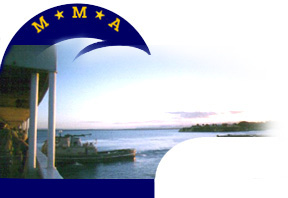
Captain's Log for Thursday, 03 February 2000
|
As of 0700 Eastern Standard time, 1200 GMT and 1300 ship time, the Empire State was enroute to Barcelona, Spain and located at 39 degrees 39 minutes North Latitude, 006 degrees 04 minutes East Longitude. That put the ship approximately 200 nautical miles southeast of Barcelona. We were steering a course of 297 degrees, making good a speed of 13 kts. The weather was partly cloudy with winds out of the west northwest at 7 knots. Seas were 6 feet and the ship was riding well. The air temp was 60 degrees and the sea temp was 58 degrees. Barometric pressure was 1026 millibars of mercury. Depth of water beneath the keel: 2340 Meters. CAPTAIN'S LOG Professor Malcolm MacGregor, Chairman Marine Safety and Environmental Protection Department submitted today's Captain's Log. The Marine Safety and Environmental Protection (MSEP) Department teaches three academic programs on Sea Term 2000. Freshmen, (4/C cadets) are required to participate in our four-day program that introduces concepts of Physical Oceanography, Biological Oceanography, Meteorology, and Marine Safety. The topics are briefly explained in the classroom and the unique at sea laboratory environment provides meaningful "hands on" experiences while sampling the real world. The normal daily routine begins at 0800 with morning lectures and concludes with afternoon laboratory sessions or vice versa. The laboratory exercises include towing nets and collecting plankton. Some of the specimens are then prepared for microscopic examination and identification. We also deploy expendable bathometers (XBT's). These simple oceanographic instruments are launched overboard and as they descend, water depths and temperatures are accurately measured. Temperatures usually decrease as depth increases and the water forms into successively colder layers. Cadets learn to recognize these layers (called thermoclines) and other temperature phenomena of the deep ocean, as they greatly influence the variety and numbers of sea life present. Temperature data, coupled with dissolved oxygen calculations, enable us to determine biological oxygen demand. The cadets also learn to be weather people. Meteorological measurements such as air temperature, atmospheric pressure, and relative humidity are taken and recorded several times per day. While we have the most modern weather data available to us, it is always fun to compare our predictions with that of the world's professionals. The cadets always do a credible job. Marine and Industrial Safety, a six credit course, is offered to First, Second and Third Class cadets on a voluntary basis. This program includes many topics relevant to Industrial and Marine Safety and, as with everything we teach, extensive laboratory work is required. For example, these students have monitored noise levels and temperatures in the Engine room and galley and have calculated air flow and ventilation rates for our berthing spaces. Their work is instrumental in making our working and living spaces as safe and comfortable as possible. The MSEP Department also offers an independent study program. The curriculum presents our students with opportunities to complete a variety of projects including the worldwide classroom, solid waste management, and wastewater treatment. Motivated cadets may also work as laboratory assistants and ship safety officers. The worldwide classroom is our most popular independent study program. Our cadets interact with grade school students from throughout Massachusetts and the Northeast. They author the cruise questions that appear with the daily Captain's Log, communicate regularly with the classrooms and provide much of the color commentary about our port stops. It is easy to see why they enjoy it so. Well, speaking of sampling... I am about to sample the chef's fine cuisine and maybe a hot pastry or two...Just another of the many benefits of Sea Term 2000. See you tomorrow QUESTIONS FOR FRIDAY 04 FEBRUARY 2000 GEOGRAPHY: What continent is only 10 miles south of Spain? SCIENCE: While the cadets are experiencing warm temperatures in Spain, we are enduring some prolonged cold weather. However, not cold enough for the ocean back here to freeze over. There is one ocean that does freeze over -what ocean is it and how thick is the ice? HISTORY: What is the name of the King of Spain? MATH: When the cadets complete the storage locker they must position a shelf in the middle of a bulkhead that is 19 feet wide. The shelf will be three feet wide. How many feet from the edge of the bulkhead will they position the shelf? ANSWERS FOR THURSDAY 03 FEBRUARY 2000 GEOGRAPHY: Pyrenees. SCIENCE: No. Seaweed's are not really weeds but large forms of marine algae that grow in the coastal waters of many countries. HISTORY: North Atlantic Treaty Organization. MATH: Complement of a 51 degree angle is 39 degrees. The supplement of a 35 degree angle is 145 degrees.
|
|
||||||||||||||||||||||||||||||||||||||||||||||||||